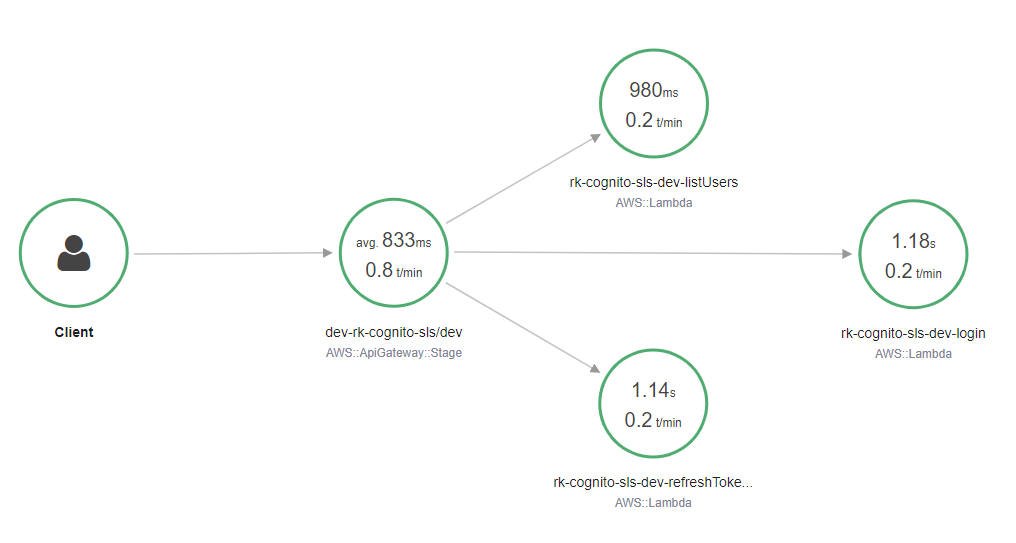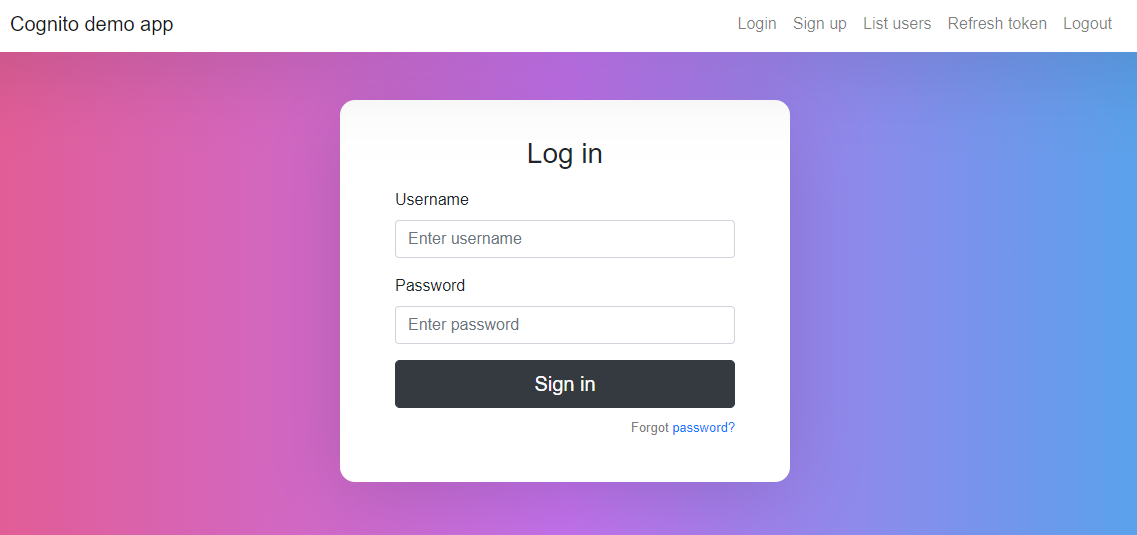- Node.js (version: ^14.17.1 )
- AWS CLI (version: ^2.2.13 ) - configured credentials
- Python (version ^3.8.8 )
Firstly we need to install serverless framework with command npm i -g serverless, it is installed globally so we can run it from anywhere.
in /serverless-cognito-service run npm i. It will install serverless plugins ( defined in package.json):
- serverless-python-requirements
- serverless-finch
and also it'll install python libraries defined in unit-test-req.txt, required for unit test which you can run with npm run test
You should see something like this:
src/tests/tests.py::test_login_username_doesnt_exists PASSED
src/tests/tests.py::test_login_username_wrong_password PASSED
src/tests/tests.py::test_login_users PASSED
src/tests/tests.py::test_sign_up_username_exists PASSED
src/tests/tests.py::test_sign_up_new_user PASSED
src/tests/tests.py::test_refresh_token FAILED
...
In /serverless-cognito-service/frontend is simple react-app-client, which calls and displays API results. To be able to build web-app, we need to install all its dependencies with npm i.
To check if it works corretly you can run npm run start and the react-app should be opened on localhost.
- in
/serverless-cognito-servicerunnpm run deploy. This command will start deploying our serverless app to AWS cloud.
After running deploy, you should see output similar to:
Service Information
service: rk-cognito-sls
stage: dev
region: eu-central-1
stack: rk-cognito-sls-dev
resources: 80
api keys:
None
endpoints:
POST - https://j12rzplytj.execute-api.eu-central-1.amazonaws.com/dev/signUp
...
POST - https://j12rzplytj.execute-api.eu-central-1.amazonaws.com/dev/resendCode
functions:
signUp: rk-cognito-sls-dev-signUp
...
resendVerificationCode: rk-cognito-sls-dev-resendVerificationCode
layers:
pythonRequirements: arn:aws:lambda:eu-central-1:365087808786:layer:rk-cognito-sls-layer:17
- in
/serverless-cognito-service/frontend/src/config.jschangeBASE_URLto generated URL from output above. This url will be used, while calling API from react-app.
Example:
export const BASE_URL = 'https://j12rzplytj.execute-api.eu-central-1.amazonaws.com/dev'
- in
/serverless-cognito-service/frontendrunnpm run build,/buildfolder with website will be created - in
/serverless-cognito-servicerunnpm run deploy-frontendThe website will be deployed into S3 bucket as static web site usingserverless-finchplugin
Now you should see output like this:
...
Serverless: Configuring policy for bucket...
Serverless: Retaining existing tags...
Serverless: Configuring CORS for bucket...
Serverless: Uploading client files to bucket...
Serverless: Success! Your site should be available at http://rk-cognito-sls-bucket.s3-website.eu-central-1.amazonaws.com/
Website location: http://rk-cognito-sls-bucket.s3-website.eu-central-1.amazonaws.com/
- Sign-up, sing-in, ... about service
- is defined as resource in
serverless.yml
- each function is defined as python script in
/src/functions/..and refferenced infunctions.<function>.handler - we are using this serverless-plugin
serverless-python-requirementsto create thelayer
Example:
from aws_xray_sdk.core import xray_recorder #aws_xray_sdk is stored in lambda layer
@xray_recorder.capture('login') #metrics for X-RAY service
@cors_headers #decorator to add CORS headers and catches Exceptions
def lambda_handler(event, context):
...- is created implicitly, by defing
functions.<function>.events - Custom authorizer (to be able to refference it to Cognito user pool)
- ApiGateway Responses (to add CORS headers to not authenticated requests)
Implicit ApiGateway definition
functions:
signUp:
handler: src/functions/signUp.lambda_handler
events:
- http:
path: /signup #endpoint path
method: post
cors: true #to add OPTIONS method
request:
schemas: # schema for JSON validation
application/json: ${file(src/schemas/signUp-request.json)}
listUsers:
handler: src/functions/listUsers.lambda_handler
events:
- http:
path: /users
method: get
cors: true
authorizer:
type: COGNITO_USER_POOLS
authorizerId: !Ref apiGatewayAuthorizer # custom authorizer defined in resources
role: listUsersRole # extra role, so we are able to get all users, role defined in resources
...ApiGateway resources
resources:
Resources:
apiGatewayAuthorizer:
Type: AWS::ApiGateway::Authorizer
Properties:
AuthorizerResultTtlInSeconds: 10
IdentitySource: method.request.header.Authorization
Name: apiGatewayAuthorizer
RestApiId:
Ref: ApiGatewayRestApi
Type: COGNITO_USER_POOLS
ProviderARNs:
- !GetAtt "cognitoUserPool.Arn"
gatewayResponse:
Type: "AWS::ApiGateway::GatewayResponse"
Properties:
ResponseParameters:
gatewayresponse.header.Access-Control-Allow-Origin: "'*'"
gatewayresponse.header.Access-Control-Allow-Headers: "'*'"
ResponseType: DEFAULT_4XX
RestApiId:
Ref: "ApiGatewayRestApi"
StatusCode: "401"
...@xray_recorderdecorator need to be added in each lambda function in order to use X-ray
In AWS console you should see service map (usage) of lambda functions.

Custom Managed policy to allow X-ray and CloudWatch
loggingPolicy:
Type: AWS::IAM::ManagedPolicy
Properties:
PolicyDocument:
Version: "2012-10-17"
Statement:
- Effect: "Allow" # xray permissions (required)
Action:
- "xray:PutTraceSegments"
- "xray:PutTelemetryRecords"
Resource:
- "*"
- Effect: Allow
Action:
- logs:CreateLogGroup
- logs:CreateLogStream
- logs:PutLogEvents
Resource:
- Fn::Sub: arn:aws:logs:${self:provider.region}:${AWS::AccountId}:log-group:/aws/lambda/*:*- used for website-hosting
- to deploy we used
serverless-finchserverless-plugin - it just copies static files from src to dest bucket
- TODO: CloudFront
- SSMPolicy Managed Policy for lambda functions
- we storing CognitoClientAppID (gateway to userpool) and CognitoUserPoolId, so lambda can connect to Cognito
resources:
Resources:
clientAppIdParameter:
Type: AWS::SSM::Parameter
Properties:
Description: clientAppId
Name: /${self:service}/clientAppId
Tier: Standard
Type: String
Value: !Ref cognitoUserPoolClient
cognitoUserPoolIdParameter:
Type: AWS::SSM::Parameter
Properties:
Description: cognitoUserPoolId
Name: /${self:service}/cognitoUserPoolId
Tier: Standard
Type: String
Value: !Ref cognitoUserPool
SSMPolicy:
Type: AWS::IAM::ManagedPolicy
Properties:
PolicyDocument:
Version: "2012-10-17"
Statement:
- Effect: Allow
Action:
- ssm:GetParameter
Resource:
- Fn::Sub: arn:aws:ssm:${self:provider.region}:${AWS::AccountId}:parameter/${self:service}/*You can invoke your function locally by using the following command:
serverless invoke local --function helloWhich should result in response similar to the following:
{
"statusCode": 200,
"body": "{\n \"message\": \"Go Serverless v2.0! Your function executed successfully!\",\n \"input\": \"\"\n}"
}
Alternatively, it is also possible to emulate API Gateway and Lambda locally by using serverless-offline plugin. In order to do that, execute the following command:
serverless plugin install -n serverless-offlineIt will add the serverless-offline plugin to devDependencies in package.json file as well as will add it to plugins in serverless.yml.
After installation, you can start local emulation with:
serverless offline
To learn more about the capabilities of serverless-offline, please refer to its GitHub repository.

